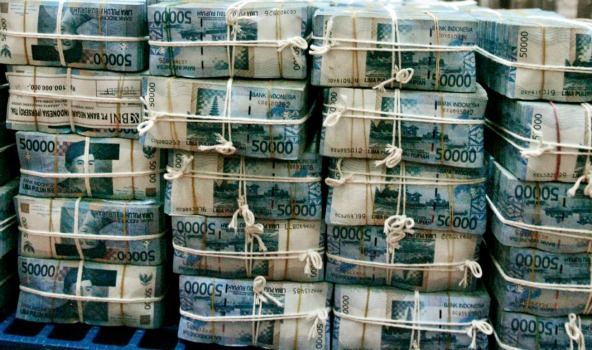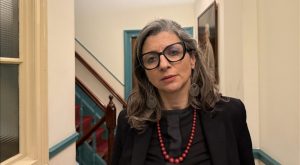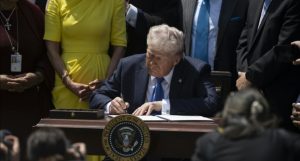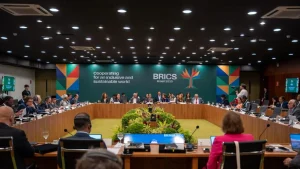
Bundles of rupiah banknotes at an Indonesian bank.
Jakarta, 14 Rabiul Akhir 1438/12 January 2017 (MINA) – A woman holds newly designed rupiah banknotes after exchanging her old bills in Jakarta last month.
Also Read: Saudi Arabia Wins Bid to Host World Expo 2030
What would eliminating three zeroes from Indonesian rupiah banknotes mean to people? For many, it would make calculation a lot simpler. It would also change perceptions of what things really cost.
For Hariyadi, a Jakarta-based architect and contractor, presenting a client with a nine-figure quotation is a problem.
“Having too many zeroes tends to create the psychological effect in a client’s mind that a project is too costly so they would bargain hard, when in fact the proposed figure is just enough to cover the minimum costs,” he told Asia Focus.
A client who sees a proposal worth 100,000,000 rupiah (US$7,500) to renovate two mid-sized rooms would typically seek a lower price, he said, even though the amount is only enough for a basic renovation.
Also Read: 148 Products from Indonesia Promoted at Sarawat Superstore Jeddah
If the rupiah were redenominated, his quote would be 100,000 rupiah. That same amount today would buy you two tall lattes at a Starbucks in Jakarta, where the rupiah was trading at 13,340 to the US dollar.
Dessy Windar, a social worker who travels abroad a lot, said rupiah redenomination would make it easier to calculate her travel budget and also impose some discipline on her spending.
“We tend to think that prices are cheaper abroad because they don’t have so many zeroes and that leads to a risk of overspending,” she said. “For example, at first glance it might seem cheap to buy a 50-dollar souvenir in Singapore, when in fact we are spending almost 500,000 rupiah in equivalent.”
Also Read: Packaging Industry Supports Halal Ecosystem
Stalled redenomination bill
The plan to redenominate the rupiah re-emerged last month when central bank governor Agus Martowardjojo called on President Joko Widodo to support legislative passage of a stalled redenomination bill.
At the launch of new rupiah banknote denominations on Dec 19, during which the president was present, Agus said prices of goods and services would adjust when the currency was simplified but he stressed that it would not reduce people’s purchasing power.
Many retailers already simplify prices with three digits less in their displays, but with a disclaimer that the prices are actually in thousands of rupiah.
Also Read: Indonesia-Japan Agree on Energy Transition Cooperation
Redenomination was first floated in 2013 by Martowardjojo, the finance minister in the previous government. He said a change was necessary because the currency system had become inefficient.
The smallest Indonesian banknote is 1,000 rupiah while the largest is 100,000, and it is the world’s second highest denomination after the Vietnamese dong, which trades at around 22,550 to the US dollar.
However, the redenomination plan was shelved due to unfavourable economic conditions and as lawmakers shifted their focus to the 2014 election. The bill returned to the agenda for the 2015-19 term but in December, the legislative committee of the House of Representatives removed it from a list of priority bills for 2017. Once more they cited unfavourable conditions and expressed concern about political meddling in the deliberations.
Also Read: Dubai Expo 2020 Holds Special Event for Palestine
People will need to be properly informed
Bank Indonesia has said that if the redenomination bill could be passed into law by 2018, it would start preparing to print new banknotes and adjust related infrastructure over the following two years. It envisages a four-year transition period from 2020-24, during which the old currency would still be valid, before the new currency becomes the only legal tender in 2025.
Fitriana Emilia, a media relations officer, believes rupiah redenomination would not make much difference as prices would adjust and people’s spending would remain the same. “Unless inflation is high, it would be a problem, because it would affect prices of goods,” she said.
Lana Soelistianingsih, an economics lecturer at Universitas Indonesia, said redenomination would depend on certain conditions, especially a stable inflation rate for a long time.
Also Read: Indonesia Increases Excise on Tobacco Products by 2022
“Our inflation rate during the past five years has been volatile. But now that the fuel subsidy has been cut off, we can expect inflation to be more stable,” she told Asia Focus.
If the plan is set in motion, she said, the government would also need to ensure the availability of smaller-denomination coins to prevent prices being rounded up in cash transactions.
“Otherwise, this practice would eventually lead to inflation, or the government could encourage more cashless transactions,” she added.
Enny Sri Hartati, an economist at the Institute for Development of Economics and Finance, said the government also would need to conduct a massive public-relations campaign to assure people that three fewer zeroes in the currency would not reduce its value.
Also Read: Indonesia to Become the Center of Sharia Economy in 2024
“We don’t want to cause moral hazard and make people think that it is sanering,” Enny said, referring to a Dutch term that roughly translates as renewal or restoration.
Older Indonesians in particular have bad memories of the term, which was used when the Soekarno government halved the value of the rupiah in 1959.
“For many, it is as simple as simplification of the rupiah. They would need to be properly informed that redenomination is not devaluation and that their money would still have the same value,” she told Asia Focus. (T/RS05/RS01)
Mi’raj Islamic News Agency (MINA)
Also Read: Indonesia to Host World Tourism Day 2022































 Mina Indonesia
Mina Indonesia Mina Arabic
Mina Arabic